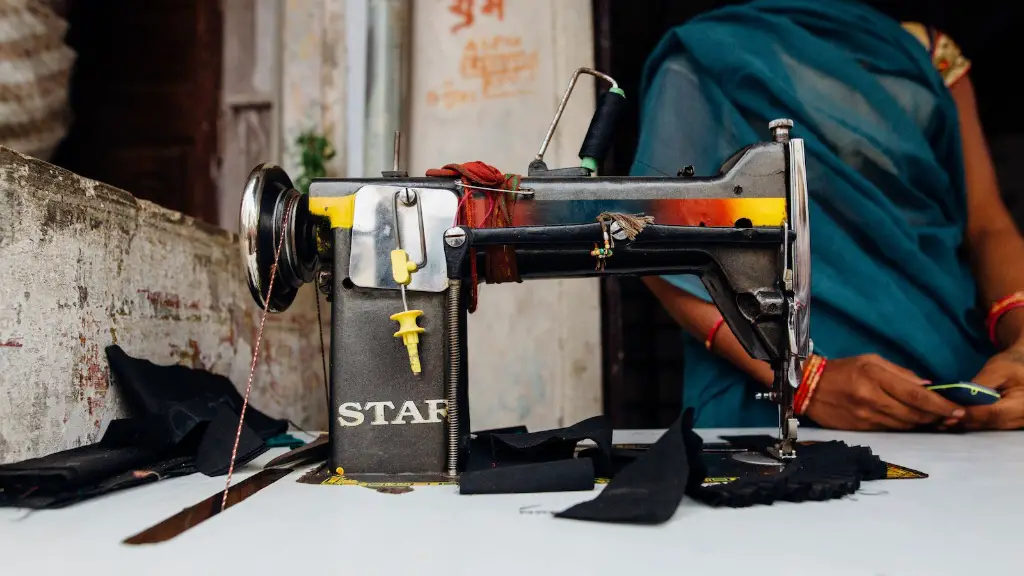Preparing the Cabinet
Painting a sewing machine cabinet requires an adequate level of skill and experience. Before beginning painting, it is important to thoroughly prepare the cabinet. The key step to effectively prepare a sewing machine cabinet for painting is to remove any dirt and grease on the surface. This can be done using a commercial cleaner as instructed on the back of the product; however a mixture of one part water and one part white vinegar will also do the trick. Additionally, it is recommended to lightly sand the area to ensure the paint adheres well to the surface of the cabinet.
Choosing the Paint
The next step of painting a sewing machine cabinet is to decide on the type of paint to use. There is a large selection of available paints, so it is important to consider the level of durability needed for the project. High performance spray paints are generally best for this task as they provide a more even coat and better protection from the elements than other types of paint can. In order to guard against the possibility of rust and corrosion, the use of a spray paint featuring a rust-inhibitor is recommended.
Painting the Cabinet
Once the cabinet is adequately prepped and the right type of paint is chosen, it is important to pay attention to a few key items to ensure the best quality finish. When applying a spray paint it is best to use gentle, sweeping motions to achieve an even coverage. Additionally, it is suggested to apply at least three coats to get the full benefit of the paint. Depending on the humidity and temperature of the environment, it is typically recommended to wait several hours, at least, between coats.
Protective Clear Coat
Once the paint has been applied, it is beneficial to apply a protective clear coat to the sewing machine cabinet. This will add an extra layer of protection for the paint job and help ensure that the paint does not chip or flake off over time. To protect the paint from fading, a UV-resistant clear coat is recommended, as this will protect your painted cabinet from the effects of the sun.
Dry Time
It is always important to refer to the instructions of the product being used while painting a sewing machine cabinet; however, in general, a painted cabinet should be allowed to dry and cure for at least 48 hours before use. Additionally, all painters and varnishes used for a project like this should be given at least 7 days before being exposed to the elements, such as rain or snow.
Clean Up
Painting any surface can be messy and sewing machine cabinets are no exceptions. It is important to use drop cloths to protect the area from paint splatter and spills. After the job is finished, be sure to clean up all brushes and rollers, as well as any other painting equipment being used. These items should be washed with a mild dish soap and water before storage.
Safety Considerations
While prepping and painting a sewing machine cabinet it is important to remember to put the safety of yourself and others first. Always wear the appropriate clothing such as masks and eye protection and have proper ventilation while using any type of paint or solvent. Additionally, it is suggested to avoid painting in extremely hot or humid conditions to prevent the paint from drying too quickly and bubbling up on the surface.
Purchasing Paint Supplies
In order to have an adequate painting supplies, it is recommended to purchase a few basic items. Those items include a spray gun, drop cloths, painter’s tape, a variety of brushes, and rollers. Additionally, sandpaper, primer, cleaners, and rust-inhibitor paint should be considered for the best possible results.
Choosing the Right Finish
Finishes used for a painting project will determine how the final product looks. There are a few different types of finishes to consider when painting a sewing machine cabinet. For example, gloss and semi-gloss paints will add a shiny finish, whereas matt and eggshell paints will provide a more subtle sheen. It will be important to choose the right finish to match the desired look of the cabinet.
Applying Multiple Coats
A successful project requires multiple coats of paint. Generally, most paints require at least three coats when painting a sewing machine cabinet. Applying multiple coats of paint provides better coverage and increases the durability of the paint. As a general guideline, it is suggested to wait at least 24 hours between coats, to ensure there is adequate time for the paint to cure.
Reinforcing the Paint
For extra protection it is possible to reinforce the painted sewing machine cabinet with a layer of clear sealant or varnish. Not only does this help to guard against the elements, such as rain, but it also allows for a more even finish and provides a layer of protection against fading. When selecting a sealant, ensure that it is formulated for outdoor surfaces and is also UV-protected.
Applying Decals and Stencils
Once the cabinet has been successfully painted, it is possible to personalise it with decals and stencils. Doing this can greatly enhance the look and feel of the cabinet and make it even more unique. Applying decals and stencils requires a steady hand, however; it is important to use a light touch and not press down too hard to avoid damaging the underlying paint.
Protecting the Paint
After a successful project, it is important to remember to properly maintain the painting job to ensure the painted cabinet lasts a long time. This can be done by wiping down the cabinet on a regular basis with a damp cloth or using a specialised paint cleaner. Additionally, it is beneficial to apply an extra layer of clear sealant every few years to protect the painted finish.



